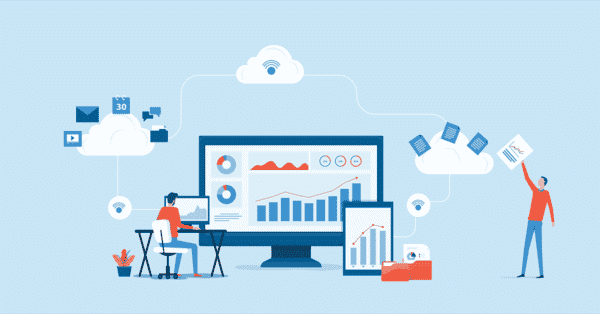
If you’re a brand or agency interested in data-driven marketing, you might be curious about using a self-service analytics solution — like Domo, a well-known player in that space.
Designed as an all-purpose business intelligence solution, Domo combines data connections and visualization in a single tool.
But is it right for your organization?
Our company has been a full-service provider of marketing analytics for a decade. We’ve helped a range of clients pick the best solution for their needs. We’ve seen and tested just about every tool out there, not just to help guide our clients during their decision-making process, but for our own analytics needs as well. Below, we’ve rounded up some feedback on Domo’s tool, looking at it from the eye of a marketer, to help you decide if this is the best tool for your marketing analytics needs.
What are Domo’s best features? Why might marketers find it appealing?
SINGLE SOLUTION // Domo is an end-to-end tool. Users can use Domo to connect data and create visualizations with a single piece of software, streamlining the reporting process.
DATA CONNECTIONS // Domo has more than hundreds of pre-built connections to data sources. Including many that are popular with marketers: MailChimp, Twitter, Google Analytics, Facebook, ExactTarget, Emma and others.
VISUALIZATIONS // Domo has earned praise for its appealing dashboards and reports.
SHARING // Users can access Domo’s reports and dashboards via mobile. Its platform is designed so users can share reports across large organizations, while controlling who can see specific reports. For marketers who need to communicate their progress to clients or executives, this could help you avoid sending around PDFs.
SELF-SERVICE // Domo aims to deliver a self-service analytics experience — an environment where marketers can create easy-to-build, easy-to-understand reports.
What Are the Potential Concerns With Domo?
NEED FOR TECHNICAL SKILLS // In a positive review, PCMag.com noted that Domo gives users the ability to mix and join datasets, so they can get new insights into their numbers. But it noted that:
On the downside, these SQL commands can get very complex and, if you don’t know SQL, you will definitely need assistance with setting things up. That can be a key weakness in a self-serve BI scenario in which the whole point is to avoid calling IT for help.
COST OF CUSTOMIZATION // Domo offers a range of pre-built options for data management and visualization, but if your organization requires a more specialized solution — if you need to customize a connection to one of their out-of-the-box data source, for example — you may need to pay Domo extra for that support.
CAPACITY FOR ANALYSIS // Domo’s card-based reporting is popular with marketers. But reporting (telling you what happened) is different from analysis (telling you why it happened and what you should do next).
Domo’s tools may not perform as well as a stack of dedicated solutions — one platform that’s built for data management, working in union with another that’s designed for in-depth data analysis and visualization. Pre-built vizzes and dashboards could limit your ability to explore your data in the manner you choose.
What Questions Should Marketers Ask About Domo?
How Do You Plan to Use Your Data?
You should make sure you’ll be able to easily share your data from inside Domo with others. For example, if you’re part of an enterprise-class organization, you might need to feed your Domo data into a larger data warehouse. Will you be able to do so? If you need to share your data with another department or a client, and they use some other business intelligence (BI) software, will they be able to analyze your dataset with the tool of their choice?
What Internal Resources Will You Need to Use Domo?
According to the vast majority of Domo’s user reviews, the solution combines power and ease of use. But you still might need staff tasked with managing your data within Domo, if you want to get the full value. As one TrustRadius reviewer noted:
Domo is great for communicating and sharing data across teams. We have two people dedicated to using the tool as well as several others who also know how to use it. It might not be the right fit for very small teams, as it does require a decent amount of upkeep.
And this from another writer:
Although charts are easy to create, you will need someone who understands the data, both before and after it is loaded into Domo.
This isn’t a necessarily a deal-breaker. But if you’re interested in Domo mostly as a visualization tool, you should realize you’ll have to devote internal resources to data management, too. And if you’re looking to evolve your organization’s approach to marketing analytics — so you can receive more refined, more in-depth analysis — you may need help beyond what Domo as a platform alone can deliver.
Is Domo Right for You?
Self-service, “off the shelf” solutions are enticing and can be a great fit for larger teams with dedicated strategic and technical resources, but marketers should realize that every marketing analytics operation needs four things to succeed:
- A platform (or technology solution)
- Experienced, well-trained people who can create data strategies, handle the technical matters, manage marketing data and use that data to answer business questions
- A standard, proven process for collecting, consolidating and analyzing media data
- A specific plan for using that marketing analytics to drive marketing decisions and ultimately create value for that business
Domo provides the first “P” — a platform. For users who just need a streamlined, sharp-looking way to report high-level results to clients or internal stakeholders, Domo might be enough.
Domo, on its own, is geared to reporting — telling you what happened. Analytics goes beyond that, explaining why you generated the results you did and suggesting what you should do next.
Domo doesn’t provide you with the people, process or plan you need to produce higher-value analytics. For that, you’ll need to have full-time employees with the expertise to handle those tasks (including the nitty-gritty technical work, which many agencies don’t have) or you need to contract with a full-service analytics provider.
For the businesses that invest in this discipline, marketing analytics can reveal a whole constellation of opportunities and threats. The critical decision is to select the right solution for your company’s needs.
Looking for a better option for your marketing analytics and reporting? Schedule a call with Alight’s team!


